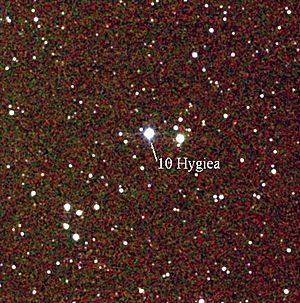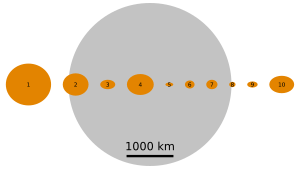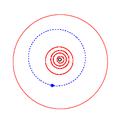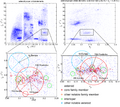10 Hygiea facts for kids

Hygiea by 2MASS
|
|
| Discovery | |
|---|---|
| Discovered by | A. de Gasparis |
| Discovery date | April 12, 1849 |
| Designations | |
| none | |
| Main belt (Hygiea family) | |
| Orbital characteristics | |
| Epoch July 14, 2004 (JD 2453200.5) | |
| Aphelion | 525.311 Gm (3.511 AU) |
| Perihelion | 413.378 Gm (2.763 AU) |
| 469.345 Gm (3.137 AU) | |
| Eccentricity | 0.119 |
| 2029.776 d (5.56 a) | |
|
Average orbital speed
|
16.76 km/s |
| 273.788° | |
| Inclination | 3.842° |
| 283.646° | |
| 313.557° | |
| Physical characteristics | |
| Dimensions | 500×385×350 km |
| Mass | 8.6 ± 0.7 ×1019 kg |
|
Mean density
|
2.4 g/cm³ |
| 0.091 m/s² | |
| 0.21 km/s | |
| 1.1510 d | |
| Albedo | 0.072 (geometric) |
| Temperature | ~164 K max: 247K (−26° C) |
|
Spectral type
|
C-type asteroid |
| 9.1 to 11.97 | |
| 5.43 | |
| 0.318" to 0.133" | |
10 Hygiea is a large space rock found in the asteroid belt. It is the fourth biggest object there. Hygiea is not perfectly round, like a ball. It measures between 350 and 500 km across. Scientists believe its mass is about 3% of the total mass of the entire asteroid belt.
Hygiea is the largest of the dark C-type asteroids. These asteroids have a surface rich in carbon. They are common in the outer part of the main asteroid belt. This area is beyond a space gap called the Kirkwood gap.
Because its surface is dark and it's far from the Sun, Hygiea looks very dim from Earth. It's one of the dimmest of the first asteroids ever found. You would need a good telescope to see it clearly.
Discovering Hygiea
Hygiea was found by Annibale de Gasparis. He discovered it on April 12, 1849. This happened in a city called Naples, in Italy. It was the first of nine asteroids he would discover.
The asteroid was named after Hygieia. She is the Greek goddess of health. She was the daughter of Asclepius, the god of medicine.
The director of the Naples observatory, Ernesto Capocci, chose the name. He first called it Igea Borbonica. This honored the ruling family of the Kingdom of the Two Sicilies. But soon, people just called it Hygiea.
What is Hygiea Like?

Hygiea's surface is made of a basic carbon-rich material. It's similar to the stuff found in certain meteorites.
Hygiea is the main body of the Hygiea family of asteroids. It holds most of the mass in this group. In fact, it has over 90% of the family's total mass.
Hygiea spins very slowly. It takes about 27 hours and 37 minutes to complete one full turn. Most large asteroids spin much faster, usually in 6 to 12 hours.
Scientists have watched Hygiea pass in front of stars. This is called a stellar occultation. These events help them learn about its size and shape. The Hubble Space Telescope has also taken pictures of Hygiea. It helped confirm that Hygiea does not have any large moons orbiting it.
Images for kids
See also
 In Spanish: (10) Hygiea para niños
In Spanish: (10) Hygiea para niños







